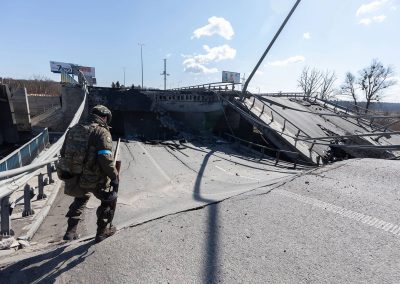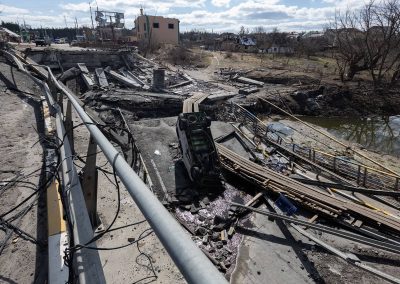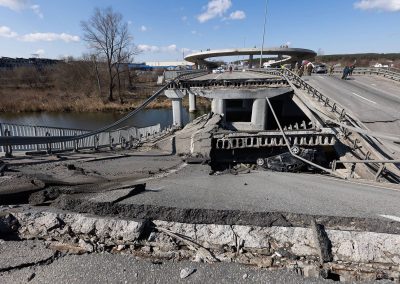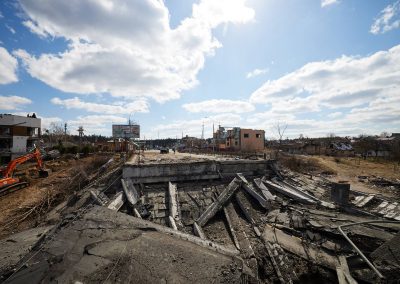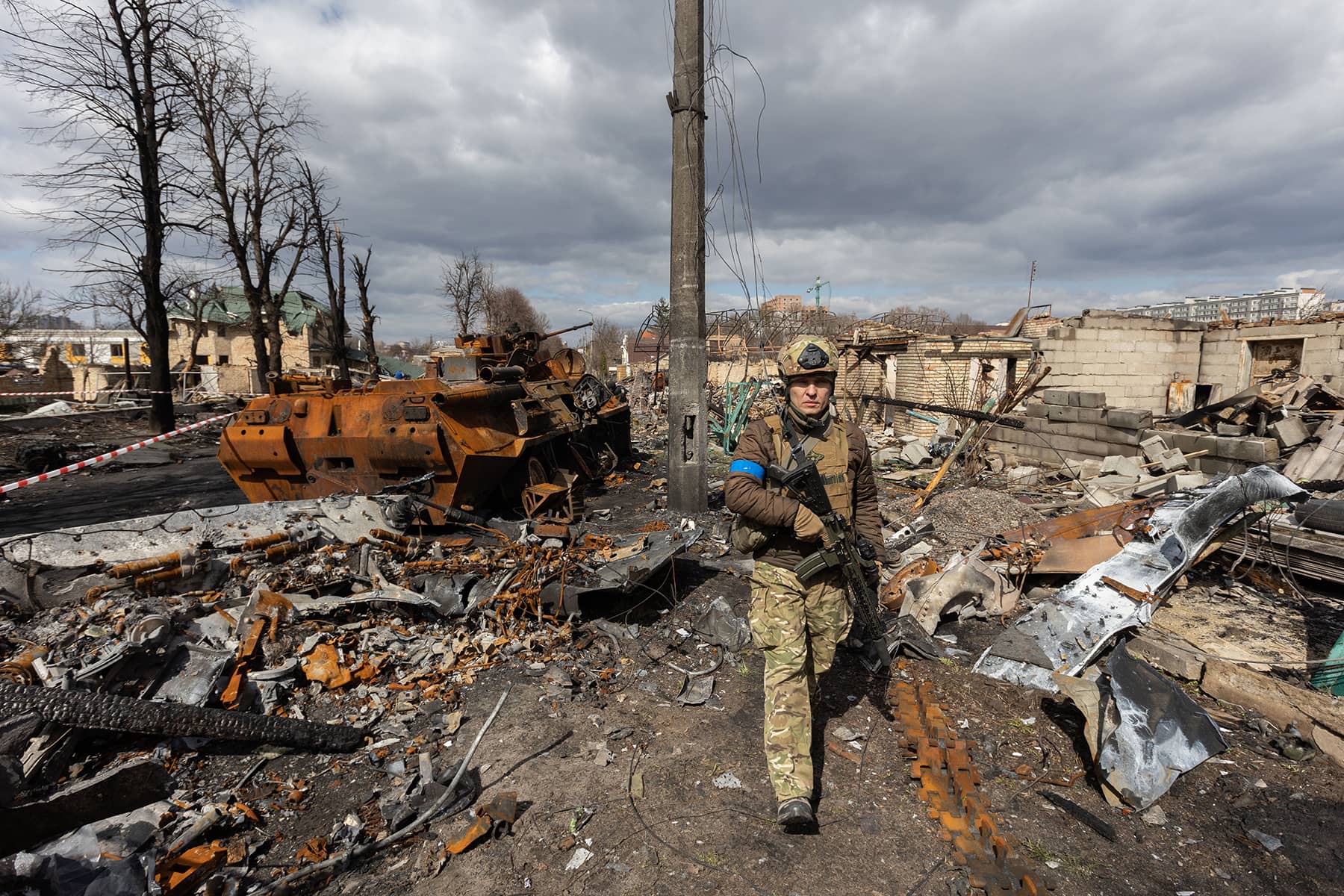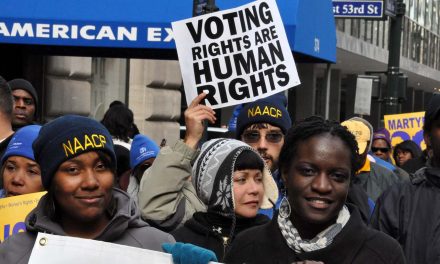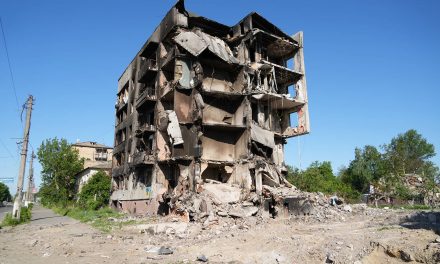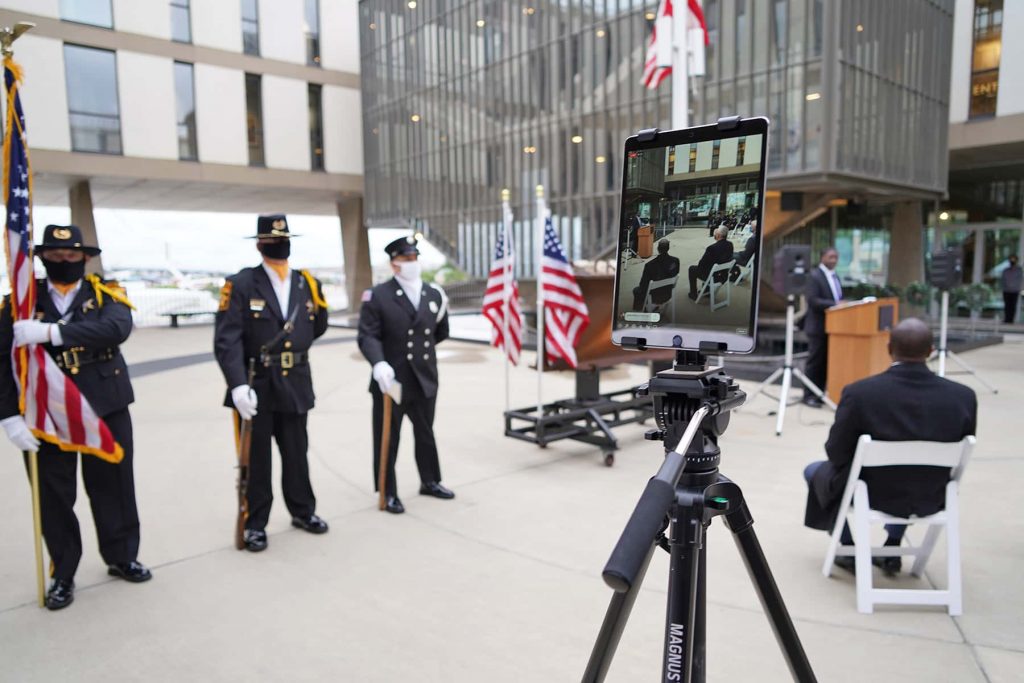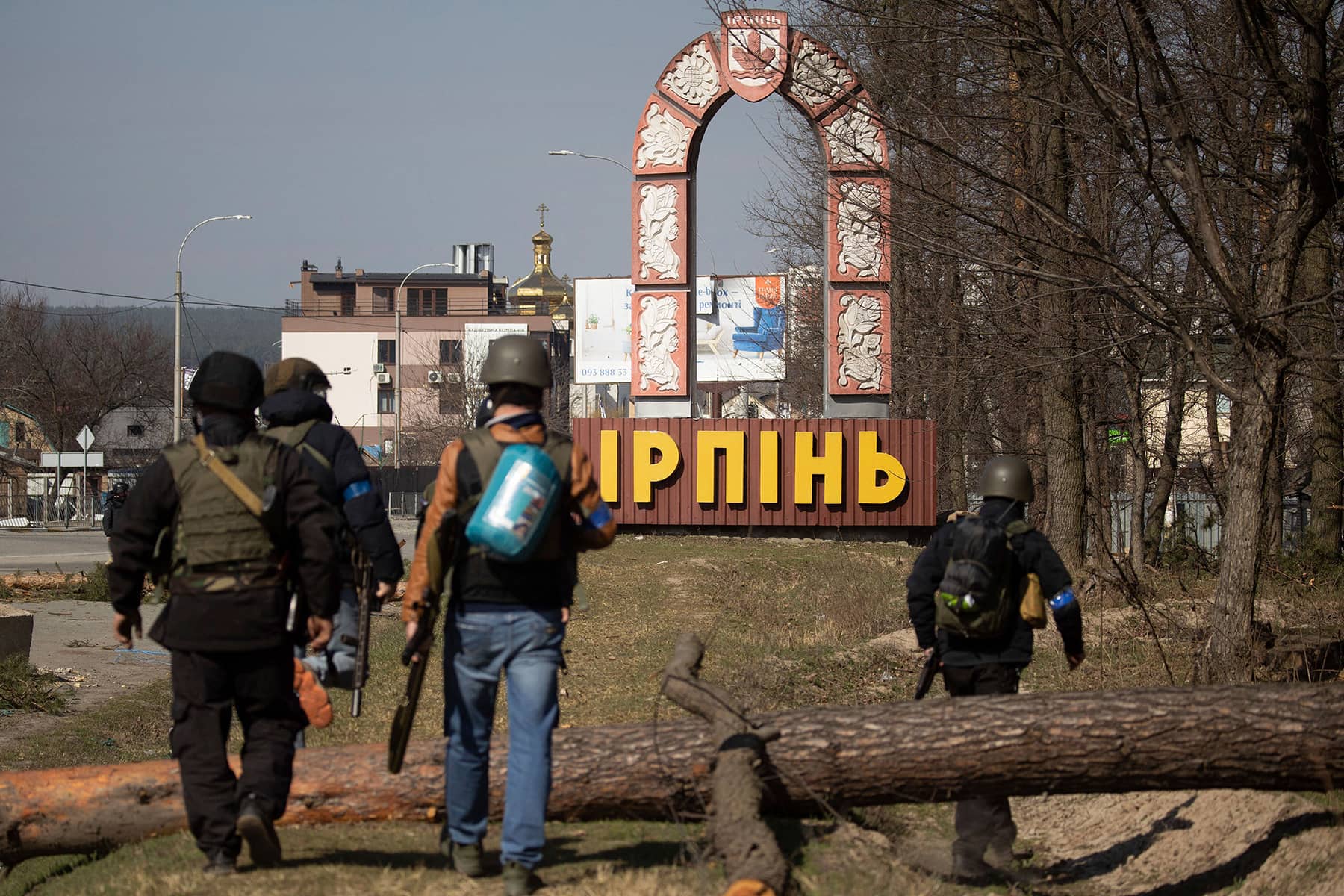
Irpin, Bucha, and Hostomel became the frontlines of the unprovoked Russian invasion for a month as Putin’s forces attempted to capture the capital city Kyiv.
Irpin was the first of the trio of cities to become free from Russian occupation on March 28. The liberation of Bucha and Hostomel followed on April 1. Also on the same day, Ukrainian Armed Forces regained control over Demidov, Dymer, and Ivankov, towns that had suffered from brutal occupation since the first days of the war. Reports were gathered from numerous sources in Irpin and participants in the counterattack, to create a chronicle of events to document the history of the war and the chapter of Ukraine’s struggle to maintain its independence.
When the horror began on February 27
A swarm of Russian helicopters attacked the airfield in Hostomel, home of the Antonov AN-225 airplane, at the beginning of the war. The first fierce battle took place there. On February 27, the first column of Russian armored forces entered Bucha. On the same day, the invading forces took heavy losses for the first time on Vokzalna Street, which was the main transportation route to Irpin. The enemy continued to push for Kyiv, but contrary to the predictions of Russian planners and Western military observers, Russian troops did not reach there in three days or thirty-three. Instead, the Ukrainian Army counterattacked.
The Russians were stopped on March 8
On March 8, military experts recorded the last successful attempt by Russian troops to attack on the right flank in the direction of Kyiv. They were moving from the formerly occupied village of Babyntsi in the direction of Kyiv with forces of up to five battalion-tactical groups, but they could not push beyond Bucha. From that moment on, Russian troops lost the ability to advance and began to prepare for defense.
On March 15, the President of Ukraine, Volodymyr Zelenskyy, appointed the head of the military administration in Kyiv region. He selected Oleksandr Pavliuk, former commander of the Ukrainian Peacekeeping forces in Kosovo. Awarded the title of Hero of Ukraine in early March, Zelenskyy appointed him to further strengthen the defense of the capital and Kyiv region.
On March 17, military experts reported that the Russians had begun digging in across the occupied territories. It was predicted that Russia would try to turn the war into one of attrition, and use its numerical advantage in artillery to destroy Kyiv and its defenders.
On March 21, the Russians were close to being able to fire not only cruise and ballistic missiles at the center of Kyiv, but also artillery. To accomplish this, however, they needed positions closer than 15 miles.
The distance was strategically important, because Russian forces had a limited supply of their expensive missiles to used against the capital’s air defense network. Artillery shells, by contrast, are virtually impossible to intercept. They are very cheap and the Russians have huge reserves. It was the use of artillery that brought the greatest destruction to Mariupol, Kharkiv, Sumy, Chernihiv, and other cities.
The first reports of a counter-offensive by Ukrainian troops surfaced on March 19 and 20. On March 22, Ukrainian Armed Forces expelled the Russians from Makarov, a village near the Zhytomyr highway, and from the village of Moshchun near Pushcha-Vodytsya, along the Irpin River and northeast of the city of Irpin. The Irpin River bank became the main barrier utilized by the defenders of Kyiv.
Due to the demolition of the dam near the village of Demydiv, the water of Irpin River – which was were previously pumped into the Kyiv Sea – overflowed and blocked the road for enemy vehicles north of the city of Irpin. The natural obstruction limited possible approaches to the capital to three, or would require the Russians to drive further South. All three bridges across the river on the Zhytomyr, Irpin, and Warsaw routes were blown up in the first days of the war.
On March 23, the first details of a siege by Russian forces in Bucha and Irpin were reported. Ukrainian troops pushed the Russians to Borodyanka and marched on the outskirts of the Warsaw route. It was along that route that the 40-mile armored convoy traveled, the main supply line for Russian invasion forces in Irpin and Bucha. The Ukrainian military was able to attack the stalled Russian vehicles at that section of the road, and destroy the rear of the Russian army near Kyiv.
There were actually two main roads for resupply at that time. The best was the Warsaw route from Bucha to Borodyanka and further – the road north to Ivankov, through the Chernobyl zone to Belarus. The second and more problematic was a little east, along the river Irpin and further to Demydiv, Dymer, and Ivankiv.
Fighting in the Russian rear in the region was also visible in satellite images. In a service provided by NASA that collects information about fires visible from space, plumes of burning smoke can be seen along the routes that Russian forces received supplies near Kyiv. The destruction was the result of Ukrainian artillery, and frequent ambushes that destroyed logistics at the Russian rear.
The military operation around Irpin-Bucha lasted for the next three days. According to military expert Tom Cooper, the Armed Forces went on the offensive, “striking in different places and at different times along the front line to disrupt the supply of Russian troops.” He described the tactic as an effective way to keep Russian artillery beyond 15 miles from Kyiv, which prevented effective strikes at the city’s center.
On March 26, it was reported that the Russian military had appointed Alexander Chayko of the Eastern Military District as commander of the 35th Separate Army near Chernobyl. He was expected to regroup Russian troops and lead them into battle. But on the March 28 there was an official announcement about the liberation of Irpin. On April 1, reports confirmed that the Russian army had left the Chernobyl zone.
Liberating cities is harder than defending
The operation to liberate Irpin began two weeks after the destruction of the Russian rear by the Ukrainian Army. Ukraine Forces recaptured street after street in close combat.
Military experts have described urban defense as a hell for any soldier. Defenders always have the advantage. They choose where to fight, and can hold back the dominant forces of the enemy. This tactic gave Ukrainians the advantage at the start of the invasion. However, once Russians captured an area the same tactic made it harder for Ukrainian troops to push them out. But Irpin was an example of Ukraine’s determination, and set the stage for the liberation of the rest of Ukraine.
A member of the Ukrainian Volunteer Corps (DUK), Danya Dansky, offered details of the operation. He participated against Russian hostilities in 2014, including the battles for Donetsk Airport. Before the war, Dansky worked in production of furniture. After the Russian invasion of Ukraine in 2014, he began military training to defend his homeland. When Putin launched his unprovoked war to seize all of Ukraine, Dansky again volunteered.
On March 20, his unit arrived in Irpin with the task of liberating the city from enemy forces. At that time, the Ukrainian military controlled the central part of the city and the bridge to Bucha near the Giraffe Mall on Soborna Street, the central street that runs through the entire city and connects Kyiv to Bucha.
On the eastern and western outskirts of the city, and on both sides at the center, were Russian troops. But they failed to completely occupy the city. Russian troops were based in a triangle in the west of the city and in the northeast.
One of the final battles took place at the intersection of Hostomel Highway, Vulytsya Severynivs Road, and 10th Street. The Pchelka store at the crossroads was the main landmark.
Dansky commanded reconnaissance and cover for his tank unit. The task of his team was to find the enemy, assess its strength, help coordinate an armored attack, and protect the tank in battle. Despite considerable armor and firepower, tanks are vulnerable to anti-tank missiles and grenade launchers. The inability of the Russians to apply basic military tactics left much of their armor without infantry support. The result was that Ukrainian forces were highly effective in the destruction of Russian tanks.
How the liberation of Irpin took place
After arriving in Irpin, Dansky’s platoon began to advance along with a collection of other units. Each day, step by step, they moved forward until the city was completely liberated. In his eight years of fighting, Dansky said he had never encountered such intense artillery fire from the enemy.
“The Russians got stuck in the buildings. They shot or burned our equipment. But the main problem was that they beat us very hard with artillery, mines, grenades, everything. “In the first 4 hours when we arrived, they fired 260 shells. We counted. Our artillery could not fire so actively at the Russians, because there were civilians everywhere. The Russian military was not worried at all about civilian casualties or destruction. We had to fight against enemy infantry and also against their armored vehicles. The enemy used tanks, infantry fighting vehicles, and even light self-propelled guns in Irpin.” – Danya Dansky
The heaviest final battles took place in the area of Hostomel Highway and the military hospital on the northern outskirts of the city. At that time the Russian occupation of Irpin was coming to an end.
“At the crossroads we met enemy infantry, when they saw our tanks gathered in one place. They were about 54 yards away and started running away after we opened up on them. The Russians left behind many weapons and equipment that will now work against them. And they also left evidence of their robberies. In places where there should be infantry gear used for fighting, we found many stolen things. They were purely looters, taking things to sell back home.” – Danya Dansky
Elite Russian forces in Irpin
The city was occupied by elite units of the Russian army. Soldiers of the 106th and 98th Airborne Divisions, the 76th and 31st Airborne Assault Divisions, and the Black Sea Fleet Marines were spotted there. These troops are the best trained and equipped units of the Russian army. It was their job to quickly capture the suburbs of Kyiv and storm the capital. But the Ukrainian people stopped their invasion and forced them to retreat.
“We saw these so-called elite troops flee very quickly. After we came in and advanced on their positions, they immediately ran away. They did not want to die, they were afraid. We were ready to stand to the end, because this is our land,. It will be liberated. Everything will be liberated, both Crimea and Donbas.” – Danya Dansky
Murders of citizens and destruction of buildings
Most Irpin residents were evacuated in late February and early March. But from the first days of spring, it became dangerous to leave the city alone, outside the humanitarian corridors. During the month of March, while the fighting continued, locals were evacuated in groups over a pedestrian crossing under the destroyed bridge to Romanivka. The efforts took place under fire and at risk of death. After the destruction of the railways, it was the only way to leave Irpin, all other areas were shelled and controlled by the enemy.
But several thousand people remained in the city during that time, in all areas including the occupied ones. For a month they lived almost without communication, without electricity, no gas, no water, and no heat. They practically did not leave their basements, because they risked their lives to go outside and look for supplies. But many did go out, and became victims of Russian war crimes. Many eyewitness accounts from surviving residents have been collected, about shootings and rapes by Russians. Ukrainian soldiers also saw evidence of those crimes when they entered the city, along with hundreds of boobytraps left behind.
Some of the residents who remained in the city could not leave their sick relatives, some simply decided that it was safer to stay at home. Among them were the elderly. At the same time, the locals helped Ukrainian soldiers, and showed them the safe ways navigate around Irpin.
Only a few days after the city’s liberation did local authorities and police have the opportunity to pick up and bury the dead. But it was a slow process because occupation forces had left numerous mines, particularly on bodies.
Most of the houses in the city were damaged or destroyed. According to Irpin’s Mayor Oleksandr Markushyn, who headed the Irpin Territorial Defense and was in the city all the time helping the townspeople, the western suburbs, the Synergy district with new buildings, and the BKZ district bordering Bucha, all suffered the most damage. The new building in the area of Hostomel Highway were severely damaged from the fighting. Thousands of private estates in all parts of the city were looted and destroyed, along with schools and businesses.
Irpin has started the slow process of cleaning up after war and is in the process of coming back to life. Despite all the attempts by Russian forces to wipe out the town, it remained defiant and victorious. Irpin was awarded the title of “Hero City” for stopping the Russian advance, and for its sacrifice. All the artillery shells, rockets, and bombs that fell on Irpin, Bucha, Hostomel could fall on Kyiv.
“We could not allow them to do this to Kyiv. Kyiv is our heart and it must beat.” – Danya Dansky
Pеtrо Bоdnar and Nаdіа Kеlm
Presidential Office of Ukraine and Rаphаеl Lаfаrguе
Translated from the Ukrainian version originally published as How Irpin was liberated: Chronicle of the counterattack of the Armed Forces of Ukraine in the north-western suburbs of Kyiv

